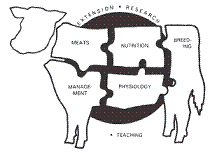Animal Science, Department of

Nebraska Beef Cattle Reports
Date of this Version
2023
Citation
2023 Nebraska Beef Cattle Report
UNL Beef, Institute of Agriculture and Natural Resources, University of Nebraska-Lincoln
Abstract
A study was conducted to determine the effect of species and maturity on yield and nutritive value of winter-hardy small cereal grains used for silage. Three species were evaluated: cereal rye, winter triticale, and winter wheat at four different stages of maturity: boot, pollination, milk, and soft dough. As species matured, yield increased across all stages, but crude protein (CP) and digestible organic matter (DOM) decreased, except at soft dough where there was a slight increase in DOM. Crude protein was greatest at the boot stage at 17.7% and least at soft dough at 9.8%. When comparing species, rye and triticale resulted in greater nutrient yield per acre. If high quality forage is the goal, harvesting at pollination appeared to increase yield without sacrificing a significant amount of nutritive value compared to boot. For maximized yield, harvesting at soft dough is a better option.
Included in
Large or Food Animal and Equine Medicine Commons, Meat Science Commons, Veterinary Preventive Medicine, Epidemiology, and Public Health Commons

